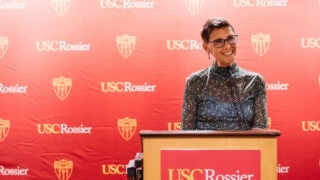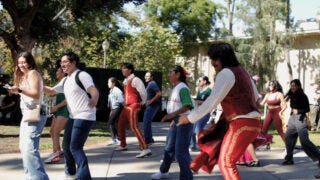New report underscores urgent need for investments in Alzheimer’s research for U.S. Latinos
Projections for U.S. Latino population indicates intensifying public health crisis, with estimated $2.35 trillion cumulative impact by 2060
Unless a medical breakthrough is discovered that prevents, cures or slows the progression of Alzheimer’s disease, the incidence and cost of Alzheimer’s on U.S. Latinos will grow exponentially by 2060, according to a report released today by the USC Edward R. Roybal Institute on Aging at the USC Suzanne Dworak-Peck School of Social Work and LatinosAgainstAlzheimer’s, a network of UsAgainstAlzheimer’s.
According to the report, “Latinos & Alzheimer’s Disease: New Numbers Behind the Crisis,” U.S. Latinos living with Alzheimer’s disease are projected to increase from 379,000 in 2012 to 1.1 million by 2030 and to 3.5 million by 2060 — a growth of 832 percent. In addition, the report released unprecedented findings on the cumulative direct and indirect costs of Alzheimer’s disease on the U.S. Latino community, including millions of family caregivers, which would ultimately cost the U.S. economy $373 billion by 2030 and $2.35 trillion (in 2012 dollars) by 2060.
“This timely report provides strong evidence of the rapidly escalating burden of Alzheimer’s disease on the U.S. Latino population,” said William Vega, co-author of the report and executive director of the USC Roybal Institute on Aging. “It is not only the growth of the prevalence that is concerning. It is also the very high metabolic syndrome and diabetes rates that are fueling the increase in Alzheimer’s to levels well beyond expected rates in the U.S. population.”
Renewed urgency
The report’s data sparks renewed urgency to address health care disparities affecting minorities, particularly U.S. Latinos. Because of advanced aged and socioeconomic determinants, U.S. Latinos are 50 percent more likely to get Alzheimer’s than non-Latino whites, yet are less likely to receive a diagnosis from a physician. Despite an increased prevalence for Alzheimer’s and other diseases, clinical trial participation among U.S. Latinos is extremely low at approximately 1 percent, punctuating the need for increased efforts to engage U.S. Latinos in clinical research.
As outlined in the report, the direct cost of Alzheimer’s includes expenditures for medical and long-term care, while indirect costs include unpaid informal care and earnings lost by people with Alzheimer’s disease. While U.S. Latinos are more likely to seek care options that are more affordable than non-Latino white Americans — for example, choosing adult day care vs. nursing home care — the total cost of Alzheimer’s on U.S. Latinos will still outpace the cost for non-Latino whites.
“Latinos living with Alzheimer’s disease rely more heavily on informal care than more expensive options like nursing home care,” said Shinyi Wu, co-author of the report and senior scientist at the USC Roybal Institute on Aging and an associate professor at USC. “Due to demographic and family structure shifts among Latinos, there will be a lower ratio of younger generations able to take care of older generations living with Alzheimer’s, placing significant societal and economic stress on Latinos.”
“Caring for my mother with Alzheimer’s is draining, but I know that it is the most important job I’ve ever done,” said Daisy Duarte, a caregiver and advocate for the LatinosAgainstAlzheimer’s Network. “Every penny I earn goes to my mother’s care, and sometimes I feel like my dreams are slipping away. I have hope, but we need help, and we need a cure.”
A goal of the report is to make sure the nation is prepared to address these disparities. To that end, the authors outlined a host of solutions that need immediate action:
- Increase research funding for Alzheimer’s to at least $2 billion annually, the level experts recommended in 2013 was the minimum needed to develop an effective treatment.
- Collaborate with government, community, philanthropic, health and industry partners on developing and implementing culturally tailored community engagement and education efforts to promote Alzheimer’s and brain health literacy and early detection among individuals, families and community stakeholders.
- Improve access to caregiver resources and informal training for caregivers in multiple languages.
- Grow the enrollment of Latinos in clinical trials by developing recruitment strategies and trial designs that better reflect the demographic heterogeneity, social needs and economic realities of Latino communities, some of which have lower health literacy, trust concerns and difficulties finding transportation.
- Recruit and train a more diverse health care provider workforce to address low diagnosis rates and improve treatment and care utilization of Latinos living with Alzheimer’s.
- Advocate for federal- and state-based action plans and goals for eliminating disparities in Alzheimer’s diagnosis, care utilization and research participation rates.
The release of the report will be followed by the inaugural 2016 Alzheimer’s and Dementia Disparities Summit on Sept. 27 in Washington, D.C., hosted by UsAgainstAlzheimer’s Latino and African-American Networks and Leaders Engaged on Alzheimer’s Disease. The summit will bring together Latino and African-American community leaders, caregivers, government officials, health care professionals and industry leaders and will focus on developing strategies and recommendations to curb the impact of Alzheimer’s and dementia on communities of color.



